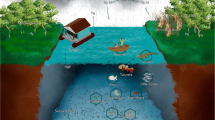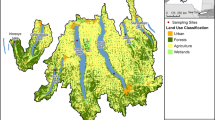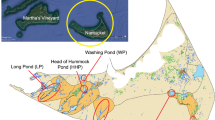Abstract
Issues regarding biomagnification of mercury (Hg) due to its persistence, bioaccumulation, and toxicity in freshwater lakes have gained much attention in the last two decades especially in remote regions of the world where anthropogenic inputs are considered as negligible. In this study, spatial distribution of total mercury (THg), interspecific accumulation patterns, trophic transfer, and associated health risks in fish of freshwater lakes (357–3107 masl) in Azad Kashmir, Pakistan, were investigated. THg concentrations in the regions were 0.20 ± 0.08 μg g−1 in glacial, 0.54 ± 0.21 μg g−1 in rural, and 1.35 ± 0.46 μg g−1 in urban region. Omnivorous, herbivorous, and carnivorous fish showed THg concentrations of 0.94, 0.85, and 0.49 μg g−1. Regional, lake, trophic level, and specie-specific differences of THg accumulation were found significant in the study. Among growth parameters, length and age varied significantly among species, trophic levels, and lakes, whereas weight showed significant variation among lakes as well. Condition factor (K) showed significant differences within species, lakes, and trophic levels. Biomagnification was observed in all lakes with the trophic magnification slopes (TMS) ranging from 0.03 to 0.20 with an average of 0.094 ± 0.07. Isotopic values of nitrogen (δ15N) and condition factor were found to dominate THg accumulation trends; however, no significant health risks were found in the study.
Graphical Abstract






Similar content being viewed by others
Abbreviations
- ASTDR:
-
Agency for Toxic Substances and Disease Registry
- Hg:
-
Mercury
- LRAT:
-
Long-range atmospheric transport
- SPL:
-
Substance Priority List
- THg:
-
Total mercury
- TMF:
-
Trophic magnification factor
- TMS:
-
Trophic magnification slope
References
Belger L, Forsberg BR (2006) Factors controlling Hg levels in two predatory fish species in the Negro river basin, Brazilian Amazon. Sci Total Environ 367(1):451–459
Jinadasa B, Fowler SW (2019) Critical review of mercury contamination in Sri Lankan fish and aquatic products. Mar Pollut Bull 149:110526
Zhang Q, Pan K, Kang S, Zhu A, Wang W-X (2014) Mercury in wild fish from high-altitude aquatic ecosystems in the Tibetan Plateau. Environ Sci Technol 48(9):5220–5228
Nimick DA, Caldwell RR, Skaar DR, Selch TM (2013) Fate of geothermal mercury from Yellowstone National Park in the Madison and Missouri Rivers, USA. Sci Total Environ 443:40–54
Shao J, Shi J, Duo B, Liu C, Gao Y, Fu J, Yang R, Jiang G (2016) Mercury in alpine fish from four rivers in the Tibetan Plateau. J Environ Sci 39:22–28
Ha E, Basu N, Bose-O’Reilly S, Dórea JG, McSorley E, Sakamoto M, Chan HM (2017) Current progress on understanding the impact of mercury on human health. Environ Res 152:419–433
Evers DC, Burgess NM, Champoux L, Hoskins B, Major A, Goodale WM, Taylor RJ, Poppenga R, Daigle T (2005) Patterns and interpretation of mercury exposure in freshwater avian communities in northeastern North America. Ecotoxicology 14(1-2):193–221
Monikh FA, Karami O, Hosseini M, Karami N, Bastami AA, Ghasemi AF (2013) The effect of primary producers of experimental aquatic food chains on mercury and PCB153 biomagnification. Ecotoxicol Environ Saf 94:112–115
ASTDR (2017) Substance Priority List. http://www.atsdr.cdc.gov/SPL/. Accessed 14 Nov 2020
WHO (2017) Mercury and health. https://www.who.int/news-room/fact-sheets/detail/mercury-and-health. Accessed 22-03-2020
Monroy M, Maceda-Veiga A, de Sostoa A (2014) Metal concentration in water, sediment and four fish species from Lake Titicaca reveals a large-scale environmental concern. Sci Total Environ 487:233–244
Baker MR, Schindler DE, Holtgrieve GW, St. Louis VL (2009) Bioaccumulation and transport of contaminants: migrating sockeye salmon as vectors of mercury. Environ Sci Technol 43(23):8840–8846
Mergler D, Anderson HA, Chan LHM, Mahaffey KR, Murray M, Sakamoto M, Stern AH (2007) Methylmercury exposure and health effects in humans: a worldwide concern. AMBIO 36(1):3–11
Monferrán MV, Garnero P, de los Angeles Bistoni M, Anbar AA, Gordon GW, Wunderlin DA (2016) From water to edible fish. Transfer of metals and metalloids in the San Roque Reservoir (Córdoba, Argentina). Implications associated with fish consumption. Ecol Indic 63:48–60
Bradley MA, Barst BD, Basu N (2017) A review of mercury bioavailability in humans and fish. Int J Environ Res Public Health 14(2):169
Arcagni M, Juncos R, Rizzo A, Pavlin M, Fajon V, Arribére MA, Horvat M, Guevara SR (2018) Species-and habitat-specific bioaccumulation of total mercury and methylmercury in the food web of a deep oligotrophic lake. Sci Total Environ 612:1311–1319
Kidd KA, Muir DC, Evans MS, Wang X, Whittle M, Swanson HK, Johnston T, Guildford S (2012) Biomagnification of mercury through lake trout (Salvelinus namaycush) food webs of lakes with different physical, chemical and biological characteristics. Sci Total Environ 438:135–143
Eagles-Smith CA, Ackerman JT, Willacker JJ, Tate MT, Lutz MA, Fleck JA, Stewart AR, Wiener JG, Evers DC, Lepak JM (2016) Spatial and temporal patterns of mercury concentrations in freshwater fish across the Western United States and Canada. Sci Total Environ 568:1171–1184
Lescord GL, Kidd KA, Kirk JL, O’Driscoll NJ, Wang X, Muir DC (2015) Factors affecting biotic mercury concentrations and biomagnification through lake food webs in the Canadian high Arctic. Sci Total Environ 509:195–205
Lavoie RA, Jardine TD, Chumchal MM, Kidd KA, Campbell LM (2013) Biomagnification of mercury in aquatic food webs: a worldwide meta-analysis. Environ Sci Technol 47(23):13385–13394
Ethier A, Scheuhammer A, Bond D (2008) Correlates of mercury in fish from lakes near Clyde Forks, Ontario, Canada. Environ Pollut 154(1):89–97
Økelsrud A, Lydersen E, Fjeld E (2016) Biomagnification of mercury and selenium in two lakes in southern Norway. Sci Total Environ 566:596–607
Lavigne M, Lucotte M, Paquet S (2010) Relationship between mercury concentration and growth rates for walleyes, northern pike, and lake trout from Quebec lakes. N Am J Fish Manag 30(5):1221–1237
Schafer HA, Hershelman GP, Young DR, Mearns AJ (1981) Contaminants in ocean food webs. Coast Water Res Pro Bienn Rep Years 1982:17–28
Verdouw JJ, Macleod CK, Nowak BF, Lyle JM (2011) Implications of age, size and region on mercury contamination in estuarine fish species. Water Air Soil Pollut 214(1-4):297–306
Castilhos Z, Rodrigues-Filho S, Cesar R, Rodrigues AP, Villas-Bôas R, de Jesus I, Lima M, Faial K, Miranda A, Brabo E (2015) Human exposure and risk assessment associated with mercury contamination in artisanal gold mining areas in the Brazilian Amazon. Environ Sci Pollut Res 22(15):11255–11264
Liu G, Cai Y, O'Driscoll N (2011) Environmental chemistry and toxicology of mercury. John Wiley & Sons, Inc., Hoboken
Rognerud S, Grimalt J, Rosseland B, Fernandez P, Hofer R, Lackner R, Lauritzen B, Lien L, Massabuau J, Ribes A (2002) Mercury and organochlorine contamination in brown trout (Salmo trutta) and arctic charr (Salvelinus alpinus) from high mountain lakes in Europe and the Svalbard archipelago. Water Air Soil Pollut 2(2):209–232
Blais JM, Charpentié S, Pick F, Kimpe LE, Amand AS, Regnault-Roger C (2006) Mercury, polybrominated diphenyl ether, organochlorine pesticide, and polychlorinated biphenyl concentrations in fish from lakes along an elevation transect in the French Pyrénées. Ecotoxicol Environ Saf 63(1):91–99
Marusczak N, Larose C, Dommergue A, Paquet S, Beaulne J-S, Maury-Brachet R, Lucotte M, Nedjai R, Ferrari CP (2011) Mercury and methylmercury concentrations in high altitude lakes and fish (Arctic charr) from the French Alps related to watershed characteristics. Sci Total Environ 409(10):1909–1915
Drevnick PE, Roberts AP, Otter RR, Hammerschmidt CR, Klaper R, Oris JT (2008) Mercury toxicity in livers of northern pike (Esox lucius) from Isle Royale, USA. Comp Biochem Physiol C Toxicol Pharmacol 147(3):331–338
Lindeberg C, Bindler R, Bigler C, Rosén P, Renberg I (2007) Mercury pollution trends in subarctic lakes in the northern Swedish mountains. AMBIO 36(5):401–405
Drenner RW, Chumchal MM, Jones CM, Lehmann CM, Gay DA, Donato DI (2013) Effects of mercury deposition and coniferous forests on the mercury contamination of fish in the South Central United States. Environ Sci Technol 47(3):1274–1279
Shanley JB, Bishop K (2012) Mercury cycling in terrestrial watersheds. Mercury in the Environment: Pattern and Process
Zhang H, R-s Y, X-b F, Sommar J, Anderson CW, Sapkota A, X-w F, Larssen T (2013) Atmospheric mercury inputs in montane soils increase with elevation: evidence from mercury isotope signatures. Sci Rep 3:3322
Phillips VJ, St. Louis VL, Cooke CA, Vinebrooke RD, Hobbs WO (2011) Increased mercury loadings to western Canadian alpine lakes over the past 150 years. Environ Sci Technol 45(6):2042–2047
Szopka K, Karczewska A, Kabała C (2011) Mercury accumulation in the surface layers of mountain soils: a case study from the Karkonosze Mountains, Poland. Chemosphere 83(11):1507–1512
Fu X, Feng X, Dong Z, Yin R, Wang J, Yang Z, Zhang H (2010) Atmospheric gaseous elemental mercury (GEM) concentrations and mercury depositions at a high-altitude mountain peak in south China. Atmos Chem Phys 10(5):2425–2437
Pirrone N, Cinnirella S, Feng X, Finkelman R, Friedli H, Leaner J, Mason R, Mukherjee A, Stracher G, Streets D (2010) Global mercury emissions to the atmosphere from anthropogenic and natural sources. Atmos Chem Phys 10(13):5951–5964
Chen CY, Dionne M, Mayes BM, Ward DM, Sturup S, Jackson BP (2009) Mercury bioavailability and bioaccumulation in estuarine food webs in the Gulf of Maine. Environ Sci Technol 43(6):1804–1810
Razavi NR, Arts MT, Qu M, Jin B, Ren W, Wang Y, Campbell LM (2014) Effect of eutrophication on mercury, selenium, and essential fatty acids in Bighead Carp (Hypophthalmichthys nobilis) from reservoirs of eastern China. Sci Total Environ 499:36–46
Azevedo-Silva CE, Almeida R, Carvalho DP, Ometto JP, de Camargo PB, Dorneles PR, Azeredo A, Bastos WR, Malm O, Torres JP (2016) Mercury biomagnification and the trophic structure of the ichthyofauna from a remote lake in the Brazilian Amazon. Environ Res 151:286–296
Driscoll CT, Mason RP, Chan HM, Jacob DJ, Pirrone N (2013) Mercury as a global pollutant: sources, pathways, and effects. Environ Sci Technol 47(10):4967–4983
Blackwell BD, Driscoll CT (2015) Deposition of mercury in forests along a montane elevation gradient. Environ Sci Technol 49(9):5363–5370
Li P, Feng X, Qiu G, Shang L, Li Z (2009) Mercury pollution in Asia: a review of the contaminated sites. J Hazard Mater 168(2-3):591–601
Fliedner A, Rüdel H, Knopf B, Weinfurtner K, Paulus M, Ricking M, Koschorreck J (2014) Spatial and temporal trends of metals and arsenic in German freshwater compartments. Environ Sci Pollut Res 21(8):5521–5536
Ali U, Sweetman AJ, Riaz R, Li J, Zhang G, Jones KC, Malik RN (2018) Sedimentary black carbon and organochlorines in Lesser Himalayan Region of Pakistan: relationship along the altitude. Sci Total Environ 621:1568–1580
Horká P, Ibbotson A, Jones J, Cove R, Scott L (2010) Validation of scale-age determination in European grayling Thymallus thymallus using tag-recapture analysis. J Fish Biol 77(1):153–161
Lomonte C, Gregory D, Baker AJ, Kolev SD (2008) Comparative study of hotplate wet digestion methods for the determination of mercury in biosolids. Chemosphere 72(10):1420–1424
Bremner JM, Keeney DR (1965) Steam distillation methods for determination of ammonium, nitrate and nitrite. Anal Chim Acta 32:485–495. https://doi.org/10.1016/S0003-2670(00)88973-4
Jin S, Yan X, Zhang H, Fan W (2015) Weight–length relationships and Fulton’s condition factors of skipjack tuna (Katsuwonus pelamis) in the western and central Pacific Ocean. PeerJ 3:e758
Łuczyńska J, Paszczyk B, Łuczyński MJ (2018) Fish as a bioindicator of heavy metals pollution in aquatic ecosystem of Pluszne Lake, Poland, and risk assessment for consumer’s health. Ecotoxicol Environ Saf 153:60–67
Ali H, Khan E (2018) Assessment of potentially toxic heavy metals and health risk in water, sediments, and different fish species of River Kabul, Pakistan. Hum Eco Risk Assess Int J 24(8):2101–2118
FAO F (2012) Agriculture Organization of the United Nations. 2012. FAO statistical yearbook
Mahmood A, Malik RN, Li J, Zhang G (2014) Human health risk assessment and dietary intake of organochlorine pesticides through air, soil and food crops (wheat and rice) along two tributaries of river Chenab, Pakistan. Food Chem Toxicol 71:17–25
USEPA (2014) Methylmercury (MeHg) (CASRN 22967-92-6). Referenced dose for chronic oral exposure (RfD) integrated risk information system. https://cfpub.epa.gov/ncea/iris2/chemicalLanding.cfm?substance_nmbr=73. Accessed 1/04 2020
USEPA (2014) HHRAP: Chapter 7 Characterizing Risk and Hazard | US EPA ARCHIVE DOCUMENT https://archive.epa.gov/epawaste/hazard/tsd/td/web/pdf/05hhrap7.pdf. Accessed 1/04 2020
Nevado JB, Martín-Doimeadios RR, Bernardo FG, Moreno MJ, Herculano AM, Do Nascimento J, Crespo-López ME (2010) Mercury in the Tapajós River basin, Brazilian Amazon: a review. Environ Int 36(6):593–608
Økelsrud A, Lydersen E, Moreno C, Fjeld E (2017) Mercury and selenium in free-ranging brown trout (Salmo trutta) in the River Skienselva watercourse, Southern Norway. Sci Total Environ 586:188–196
Poste AE, Muir DC, Guildford SJ, Hecky RE (2015) Bioaccumulation and biomagnification of mercury in African lakes: the importance of trophic status. Sci Total Environ 506:126–136
Siddiqui M, Moinuddin A, Nasrullah K, Khan I (2010) A quantitative description of moist temperate conifer forests of Himalayan region of Pakistan and Azad kashmir. Int J Biol Biotechnol 7(3):175–185
Basharat M, Rohn J, Khan MR (2014) Effect of drawdown of Karli Lake, A Case Study of Karli landslide hazard in District Hattian, Northeast Himalayas of Pakistan. Life Sci J 11(9):610–616
Lino A, Kasper D, Guida Y, Thomaz J, Malm O (2018) Mercury and selenium in fishes from the Tapajós River in the Brazilian Amazon: an evaluation of human exposure. J Trace Elem Med Biol 48:196–201
Anual ZF, Maher W, Krikowa F, Hakim L, Ahmad NI, Foster S (2018) Mercury and risk assessment from consumption of crustaceans, cephalopods and fish from West Peninsular Malaysia. Microchem J 140:214–221
Feng X, Meng B, Yan H, Fu X, Yao H, Shang L (2018) Biogeochemical cycle of mercury in reservoir systems in Wujiang River Basin. Springer, Southwest China
Cebalho EC, Díez S, dos Santos FM, Muniz CC, Lázaro W, Malm O, Ignácio AR (2017) Effects of small hydropower plants on mercury concentrations in fish. Environ Sci Pollut Res 24(28):22709–22716
Yohannes YB, Ikenaka Y, Nakayama SM, Saengtienchai A, Watanabe K, Ishizuka M (2013) Organochlorine pesticides and heavy metals in fish from Lake Awassa, Ethiopia: insights from stable isotope analysis. Chemosphere 91(6):857–863
Arcagni M, Rizzo A, Juncos R, Pavlin M, Campbell LM, Arribére MA, Horvat M, Guevara SR (2017) Mercury and selenium in the food web of Lake Nahuel Huapi, Patagonia, Argentina. Chemosphere 166:163–173
Yi Y, Zhang S (2012) The relationships between fish heavy metal concentrations and fish size in the upper and middle reach of Yangtze River. Procedia Environ Sci 13:1699–1707
Sackett DK, Cope WG, Rice JA, Aday DD (2013) The influence of fish length on tissue mercury dynamics: implications for natural resource management and human health risk. Int J Environ Res Public Health 10(2):638–659
Parente T, Hauser-Davis R (2013) The use of fish biomarkers in the evaluation of water pollution. In: de Almeida EA, & de Oliveira Ribeiro, C. A. (ed) Pollution and fish health in tropical ecosystems. CRC Press, Boca Raton, pp 164–181
Ahmed AS, Sultana S, Habib A, Ullah H, Musa N, Hossain MB, Rahman MM, Sarker MSI (2019) Bioaccumulation of heavy metals in some commercially important fishes from a tropical river estuary suggests higher potential health risk in children than adults. PLoS One 14(10):e0219336
Jardine TD, Kidd KA, O’Driscoll N (2013) Food web analysis reveals effects of pH on mercury bioaccumulation at multiple trophic levels in streams. Aquat Toxicol 132:46–52
Lavoie RA, Hebert CE, Rail J-F, Braune BM, Yumvihoze E, Hill LG, Lean DR (2010) Trophic structure and mercury distribution in a Gulf of St. Lawrence (Canada) food web using stable isotope analysis. Sci Total Environ 408(22):5529–5539
Saros JE, Rose KC, Clow DW, Stephens VC, Nurse AB, Arnett HA, Stone JR, Williamson CE, Wolfe AP (2010) Melting alpine glaciers enrich high-elevation lakes with reactive nitrogen. Environ Sci Technol 44(13):4891–4896
Food, Nations AOotU (2012) The state of world fisheries and aquaculture. FAO Rome
SCOOP E (2004) Report from Task 3.2. 11: assessment of the dietary exposure to arsenic, cadmium, lead and mercury of the population of the EU Member States. European Commission, Directorate-General Health and Consumer Protection SCOOP report
Wang YC, McPherson K, Marsh T, Gortmaker SL, Brown M (2011) Health and economic burden of the projected obesity trends in the USA and the UK. Lancet 378(9793):815–825
Bogdanović T, Ujević I, Sedak M, Listeš E, Šimat V, Petričević S, Poljak V (2014) As, Cd, Hg and Pb in four edible shellfish species from breeding and harvesting areas along the eastern Adriatic Coast, Croatia. Food Chem 146:197–203
Zhuang P, Z-a L, McBride MB, Zou B, Wang G (2013) Health risk assessment for consumption of fish originating from ponds near Dabaoshan mine, South China. Environ Sci Pollut Res 20(8):5844–5854
Acknowledgments
The authors are grateful to Mr. Tariq Javed, principal scientist, Isotope Analysis Division, Pakistan Institute of Nuclear Science and Technology (PINSTECH), for aiding in the stable isotopic analysis of nitrogen. In addition, we deeply thank the Department of Environmental Sciences, Fatima Jinnah Women University, Rawalpindi, for the analysis of THg at their facility.
Author information
Authors and Affiliations
Corresponding author
Ethics declarations
Conflict of Interest
The authors declare that they have no conflict of interest.
Additional information
Publisher’s Note
Springer Nature remains neutral with regard to jurisdictional claims in published maps and institutional affiliations.
Highlights
• A comparative study on distribution and biomagnification of THg in freshwater lakes
• Site and species-specific differences in THg accumulation were observed.
• Feeding modes and growth parameters explained variability in concentrations.
• Trophic transfer of THg was observed with regression slopes > 0.
• No significant health risk was found.
Supplementary Information
ESM 1
(DOCX 77.5 kb)
Rights and permissions
About this article
Cite this article
Hina, N., Riaz, R., Ali, U. et al. A Quantitative Assessment and Biomagnification of Mercury and Its Associated Health Risks from Fish Consumption in Freshwater Lakes of Azad Kashmir, Pakistan. Biol Trace Elem Res 199, 3510–3526 (2021). https://doi.org/10.1007/s12011-020-02479-z
Received:
Accepted:
Published:
Issue Date:
DOI: https://doi.org/10.1007/s12011-020-02479-z




